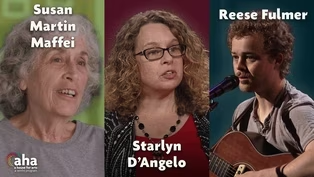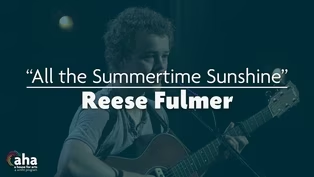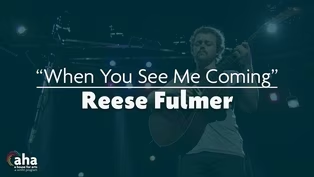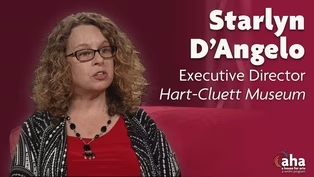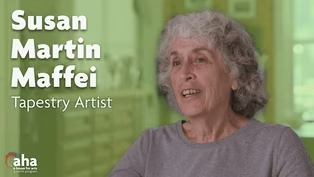
AHA! | 710
Season 7 Episode 10 | 28m 45sVideo has Closed Captions
Woven environmental messages, surprising history of Troy, and Reese Fulmer performs.
Learn about the environmental messages woven inter Susan Martin Maffei's latest body of work. Learn about what surprised Hart-Cluett Museum Executive Director Starlyn D'Angelo most about the history of Troy. Reese Fulmer performs "All the Summertime Sunshine" at WMHT Studios.
Problems playing video? | Closed Captioning Feedback
Problems playing video? | Closed Captioning Feedback
AHA! A House for Arts is a local public television program presented by WMHT
Support provided by M&T Bank, the Leo Cox Beach Philanthropic Foundation, and is also provided by contributors to the WMHT Venture Fund including Chet and Karen Opalka, Robert & Doris...

AHA! | 710
Season 7 Episode 10 | 28m 45sVideo has Closed Captions
Learn about the environmental messages woven inter Susan Martin Maffei's latest body of work. Learn about what surprised Hart-Cluett Museum Executive Director Starlyn D'Angelo most about the history of Troy. Reese Fulmer performs "All the Summertime Sunshine" at WMHT Studios.
Problems playing video? | Closed Captioning Feedback
How to Watch AHA! A House for Arts
AHA! A House for Arts is available to stream on pbs.org and the free PBS App, available on iPhone, Apple TV, Android TV, Android smartphones, Amazon Fire TV, Amazon Fire Tablet, Roku, Samsung Smart TV, and Vizio.
Providing Support for PBS.org
Learn Moreabout PBS online sponsorship(upbeat music plays) - [Lara] Susan Maffei reveals the messages woven into her tapestry, the history of Troy shines bright at the Hart Cluett Museum, and catch a performance from Reese Fulmer.
It's all ahead on this episode of AHA, A House for Arts.
- [Narrator] Funding for AHA has been provided by your contribution and by contributions to the WMHT Venture Fund.
Contributors include the Leo Cox Beach Philanthropic Foundation, Chet and Karen Opalka, Robert and Doris Fischer Malesardi, the Alexander and Marjorie Hover Foundation, and the Robison Family Foundation.
- At M&T Bank, we understand that the vitality of our communities is crucial to our continued success.
That's why we take an active role in our community.
M&T Bank is pleased to support WMHT programming that highlights the arts, and we invite you to do the same.
(intense music playing) - Hi, I'm Lara Ayad, and this is AHA, A House for Arts, a place for all things creative.
Here's Matt Rogowicz with today's field segment.
- I'm here in New Baltimore, New York to speak with renowned tapestry artist, Susan Maffei, and to get a look at what she's working on next.
Follow me.
- [Susan] I am a fiber artist.
I focus mostly on tapestry, but I also do some constructions.
Tapestry is an ancient decorative art form.
The Egyptians did tapestry, so it goes back thousands and thousands of years.
There is a structure of threads that are stretched on a loom.
Colored threads are woven over them in shapes mostly, and cover entirely the structure underneath.
It was propaganda.
People back then didn't read or write, and so the pictorial aspect of it celebrated the wars, the great deeds of the kings, that type of thing.
Now it can be a whole lot of other things.
My involvement with fiber came at a very early age.
I had a brother that was very ill when I was young, a year younger, and I spent an awful lot of time with my grandmother, and my grandmother was a great needlework person.
So even before I learned to read and write, I learned how to knit, crochet, sew.
I even had a little Singer sewing machine, miniature, next to my grandmother's big one, where I would sew all my doll clothes and everything.
So I think that was my early, early interest in fiber.
Tapestry, I came to quite late actually.
I was almost 40 when I started weaving tapestry.
I was an antique dealer for a while and dealt in early American painted furniture and became intrigued by the equipment.
And that's what got me interested in weaving.
I met another tapestry weaver, a male, and he and I spent the last 35 years together, traveling, teaching, exhibiting our tapestries.
The very first tapestries that I wove were portraits.
Actually the very first one that I wove was my cat, Gus.
I think of my work in tapestry being narrative, very much so.
Telling stories, whether it's a portrait of someone and adding, you know, books that they've read or clothes that they wear, but giving you a little bit more information about them.
I grew up in a family of four children.
I was the oldest and the other three were boys.
I was a bit of a tomboy when I was young.
So, very active in sports, whether it be softball, or bowling, or even a little bit of football.
And I found as I got older, the way that I could share things with my father was actually watching sports.
(crowd cheering) I became very interested in the way they've been cutting the grass on baseball, football fields.
It's so textile-like.
It's like plaids, and something clicked, and I just started weaving.
So I've done a whole series on sports of all kinds.
♪ Three strikes you're out at the old ball game ♪ - [Susan] You have to think about building your images and you have to work from one side to the other.
You can't put the sun in the middle and then put the ground on.
You have to work in a way that's determined by the technical aspects of weaving.
Rather than it simply being something pictorial that hangs on the wall, I've been using a tunic form, which is clothing, as a representation of man's footprint in the latest series that I've been doing that is about endangered, threatened, invasive species.
I'm working on a piece that's about the honey locust tree, which is a particular tree that has these wonderful long thorns.
I mean, they can be six or eight inches long.
Unfortunately, we have been cultivating them to the point where we don't want the thorns anymore.
We don't like the thorns.
So it's a bit of a comment on man's footprint in terms of changing the world the way we want it to be.
It incorporates a lot of insects.
I've been very interested in the insect world lately.
And there is a particular lovely little green bug that only lives on the honey locust tree.
So I've been weaving them and putting them into sculptural forms.
So it's very much a construction.
The series is called The Box Series.
So all of these items are being put into boxes of some sort.
It's a bit reminiscent actually, of the Victorian curiosity boxes that they used to make that are more unusual things that people don't usually look at.
There's something about tapestry.
It's one thing to take a brush and put paint, or take a pencil and put it on a piece of paper, but there's something else about actually handling the things that you're making.
Very hard to explain the feeling of it.
But I think it's that tactile nature that keeps me in tapestry.
- Star D'Angelo is the executive director of the Hart Cluett Museum in Troy, New York.
The museum is dedicated to bringing the history of Rensselaer County to life, but what does it reveal about America's gilded age?
I sat down with Star to find out.
Star, welcome to A House for Arts.
It's such a pleasure to have you.
- I'm so pleased to be here today.
- You have over 20 years of experience working for museums and non-profits, and I understand that directing the Hart Cluett Museum is just the newest chapter in your professional journey.
So congratulations.
- Thank you very much.
- You know, I understand that the Hart Cluett is a historic house museum, and there are many different historic house museums, all over the United States.
You know, the White House is a very obvious example, Monticello, Taliesin West in Arizona.
I'm curious to know, Star, what is it that makes the Hart Cluett so unique as a house museum?
- Well, it's not just a house museum.
It operates out of two townhouses on Second Street in downtown Troy.
And so we have exhibition galleries, we have a library, a really important archive.
We hold the records of the surrogate court.
So we also have the Hart Cluett House next door, which is a really important historic townhouse from the early 19th century.
And it really is one of the few of its kind left standing today, so.
- And people lived there?
- Yes.
Several families lived there and our curator Stacy Draper has worked for 43 years documenting the stories of the people who lived in that house and recreating room settings so that we can explore how they lived their lives in that home.
And it gives us an opportunity to think about our own lives, how our communities evolve over time.
- Who were these people?
- Well, they were industrialists, really.
They were people who were establishing some of the first successful businesses in Troy.
You know, Richard Hart was a serial entrepreneur, a really brilliant man who was also a community builder.
And so he helped establish Troy and the Cluett family also were community leaders who were running businesses.
They were heavily involved in the collar business in Troy, you know, the Collar City, which is famous for the detachable collars.
So these were people who helped shape the community and they were community leaders.
We also have studied the stories of the other people who lived in the building or worked for them.
So it's not just about them, but the larger community that surrounded them and through their eyes, we can look at the past and really get a greater understanding of what life was like.
- Yeah, because I understand, Troy is traditionally thought of as a historically industrial town, right?
And you talking about these industrialists definitely drives that home.
And you know, it's making me think about, like, not only Troy as industrial or as the home of Uncle Sam, but like, since you've been directing the Hart Cluett, what's something you've discovered about the history of Troy that you think might surprise a lot of people.
- Well, you know, I've worked in the capital region in the history field for a long time, and I did not know that Troy was one of the wealthiest cities in the country at one time.
And many of the buildings built in Troy were constructed by either local architects, or famous architects from New York City who would move up to Troy and actually live in the community.
And so you see a lot of influence on New York City in terms of the architecture and the design of, especially domestic structures, like, you know, the Hart Cluett.
And most of those structures are gone.
You have the Merchant House in New York City, which is still standing, but it's my understanding that there were entire rows of houses in New York City that were modeled on the Hart Cluett House, that unfortunately no longer stand.
So for example, when HBO was filming The Gilded Age, they didn't do filming in Manhattan.
They did it in Troy because they could have an intact streetscape from the 19th century that showed architecture from several different eras throughout the 19th century, so.
- And I understand the production designer for The Gilded Age was really intent on having it look visually accurate in terms of the architecture.
And I think even the costume design, right?
And it sounds like the Hart Cluett Museum, and the surrounding neighborhood, played a really big role in that.
- Yeah, so especially Kathy Sheehan.
She is the county historian.
She's also the city historian for Troy, and honestly, she's a local treasure.
She's been studying the history of the county.
She grew up here.
She knows everybody in town and she knows all the stories.
And so she and Bob Shaw, who was the production designer for HBO, really hit it off.
I think they were very like-minded in their interest in history.
And he was very interested in accuracy and authenticity in all of those sets.
So Cathy was advising him.
I think they became fast friends through this whole process, and it was wonderful just observing their conversations.
- You know, it sounds like you've also worked with such amazing people directing the museum.
I'm curious about you though, Star.
How did you get so inspired to do this kind of work, working for museums and non-profits in New York State and particularly working at the Hart Cluett?
- When I was a teenager, I had the great fortune of having a wonderful municipal museum in my hometown in Loveland, Colorado.
And it's still there.
It's a fabulous museum, the Loveland Museum in downtown Loveland, which does both art and history.
And so, they were the ones to first, you know, open doors for me in this field.
They allowed me to write a newspaper article about my grandmother who had been a sugar beet farmer.
- And you were just a teenager at that time, right?
- Right, I was 18 when my article about my grandmother was published in the Loveland Reporter Herald.
And to me, it was amazing that the adults would listen to me and let me write something like that about my family.
You know, spending time in the kitchen with my grandmother, learning how to cook, and hearing the family stories really got me interested in storytelling, and our collective memory, and the stories that we share with each other, and how we share those stories.
- Right, and that's what museums are all about, right?
- Exactly.
- Did you find that there were any parallels between your family's history, and say the history of your town or of the surrounding community?
- Yeah, well, I grew up in a family that was not interested in art and culture and that sort of thing.
I mean, I grew up on the race track, racing motorcycles and dune buggies, and that sort of thing.
This is what my family did for fun.
There are certainly a lot of storytelling in that, but, you know, it was a really kind of gritty, kind of rough and tumble kind of culture that I came from.
And so, that Troy has the same kind of grit and tenacity is really appealing to me.
You know, learning about the history of Troy, I see, you know, this pinnacle of achievement and especially in the gilded age and when, you know, so many - Wealth in the late 19th century.
- Yeah, it was amazing, the amount of wealth and, you know, all of the style-setters were in Troy and, you know, it was the place to be, but by the mid 20th century, it had plummeted down the other direction and really was struggling in many respects.
And so now to see Troy starting to come back and especially having this wonderful appreciation for the architecture and for the history, and really almost everybody I talked to in the community has some level of appreciation for that, which is really wonderful.
- I want to pivot a little bit and talk about what the Hart Cluett has been doing more recently, like current exhibitions you have going.
I know that you're working with the Smithsonian right now with a traveling exhibition.
that's about work, right?
It's called, is it called The Way We Worked?
- Yes, The Way We Worked, it's part of the Smithsonian traveling exhibition program and their museums on main street program.
So the Smithsonian is trying to support museums all across the nation, and you can rent these exhibitions or collaborate with them to bring it into your own community.
And then what our curator, Stacy Draper, did was to work with them, to use this framework where we're exploring different types of work and how it's changed over time and connect that locally.
So when you see the exhibition, it's not about work in other places around the country.
It's specific to- - It's using local material?
- Right, it's specific to Rensselaer County.
So Stacy, you know, worked very closely with curators at the Smithsonian to tailor the exhibition to meet the needs of our own community.
So we look at, you know, Freihofer's and milk delivery, you know, and that sort of thing, which we no longer have any more.
Or one of my favorites was the people who were paid to spin records so that the factory workers would work more quickly.
So they had basically factory DJs, you know.
- I did not even know that that was a thing.
- Yeah, I didn't know!
I didn't know that either until I saw this exhibition and I think it's really, it's great.
And, Stacy had no idea when this exhibition was being put together that it would become so relevant in the pandemic.
It opened, - Right, cause we're all working from home.
Or some of us are working from home.
Some of us still have to go back out and work in person.
I'd imagine you probably have a computer and a desk in the exhibition?
- We do.
There is, you know, at the tail end of the exhibit, you do see a desk with a desktop computer there.
And the exhibition opened, I believe two or three weeks before the New York State was shut down.
- Oh wow, okay, so this is very prescient, yeah.
- Yes, and I'm sure it was heartbreaking for our curator and for all of the staff to suddenly have this wonderful exhibition just get shut down.
So fortunately the Smithsonian very kindly extended the run of the exhibition through this year.
And you know, so now we have this added layer of the pandemic and how it has affected how all of us work.
- A new layer of meaning, a new layer of relevance.
It sounds like the Hart Cluett is absolutely a place to be investing in and reinvesting in the whole community.
So, thank you so much, Star, for being on A House for Arts and sharing that.
It was such a pleasure to have you.
- Thank you very much for having me.
It was a pleasure.
- Please welcome Reese Fulmer.
- Hey, how's it going?
My name's Reese.
I'm gonna be playing a couple tunes of my own tonight.
The first tune I'm going to play is off of my upcoming debut EP.
I received a grant to fund the production of it from Saratoga Arts, recording it over at Millstone Studio in Ballston Spa.
And this tune is called, "When You See Me Coming."
It's written about facing the end of your own life and looking for some reassurance.
And in this case, looking for it from the other side.
(gentle guitar music begins) ♪ Mama, when you see me coming ♪ ♪ Let me take my time ♪ ♪ Take my hand and hold it tight ♪ ♪ Put down my hat and gun ♪ ♪ Lift me up again ♪ ♪ Through air that smells like juniper in summertime ♪ ♪ Set my face against the setting sun ♪ ♪ Mama, take me to the river, where I used to play ♪ ♪ Let me sleep alone tonight, by the water lay me down ♪ ♪ When I'm dreaming, I'll be upon the mountaintop ♪ ♪ And I'll see your face ♪ ♪ Your voice will be the only sound ♪ (gentle guitar music continues) ♪ Mama, carry me back homeward ♪ ♪ Sing a song to me ♪ ♪ Leave me where my heart's been waiting ♪ ♪ back on homely ground ♪ ♪ Tell that preacher man ♪ ♪ The birds will sing my eulogies among the trees ♪ ♪ My soul don't need no saving now ♪ ♪ My soul don't need no saving now ♪ (gentle guitar music ending) So, this last song that I'm gonna play is called, "All the Summertime Sunshine," and it's written about taking care of someone who is traveling down the road in dementia and the end is in sight.
And it's, you know, the care is 24 hours a day and it's full time and it can get hard to really appreciate the time that you have left together.
And the more I've been playing this song for people, the more I'm realizing that, you know, there's so many people that are, that have this sort of situation in their lives.
So it's based on a true story, but it really applies to a lot of situations.
So if you're out there, you know, struggling to really take every day for what it is, then I hope this song helps a little bit.
It's called, "All the Summertime Sunshine."
(gentle guitar playing) ♪ In the morning I'll make a strong cup of coffee ♪ ♪ And you'll watch the birds on the rocks by the seaside ♪ ♪ And I'll play your favorite Schubert concerto ♪ ♪ And you'll find a pear on the counter ♪ ♪ That fell from your tree ♪ ♪ And oh, doesn't it taste like heaven?
♪ ♪ In the afternoon we'll set a table for talking ♪ ♪ Find a word once or twice and we'll lose many more ♪ ♪ Watching the waves, you'll try and remember my name ♪ ♪ And I'll sit here watching ♪ ♪ The last rose you cut from the garden ♪ ♪ And oh, doesn't it smell like heaven?
♪ ♪ In the evening I'll light a bergamot candle ♪ ♪ And we'll say a prayer ♪ ♪ Like your mother did when you were young ♪ ♪ And I'll leave the light on outside in the hallway ♪ ♪ You'll turn your head on your pillow to look at the moon ♪ ♪ And oh, doesn't it look like heaven?
♪ (Reese hums and strums guitar) ♪ In the morning I'll watch the sun as it rises ♪ ♪ Out in the harbor, the fishing boats leave like they do ♪ ♪ And I'll hold your hand, tell you I love you ♪ ♪ While all the summertime sunshine comes through the window ♪ ♪ And oh, doesn't it feel like heaven?
♪ ♪ Oh, doesn't it feel like heaven?
♪ (guitar music finishes) - Thanks for joining us.
For more arts, visit wmht.org/aha and be sure to connect with WMHT on social.
I'm Lara Ayad, thanks for watching.
(percussive music plays) - [Narrator] Funding for AHA has been provided by your contribution and by contributions to the WMHT Venture Fund.
Contributors include, the Leo Cox Beach Philanthropic Foundation, Chet and Karen Opalka, Robert and Doris Fischer Malesardi, the Alexander and Marjorie Hover Foundation, and the Robison Family Foundation.
- At M&T Bank, we understand that the vitality of our communities is crucial to our continued success.
That's why we take an active role in our community.
M&T Bank is pleased to support WMHT programming that highlights the arts, and we invite you to do the same.
Video has Closed Captions
Preview: S7 Ep10 | 30s | Woven environmental messages, surprising history of Troy, and Reese Fulmer performs. (30s)
AHA! 710 | Reese Fulmer "All the Summertime Sunshine"
Video has Closed Captions
Clip: S7 Ep10 | 4m 59s | Reese Fulmer performs "All the Summertime Sunshine" at WMHT Studios. (4m 59s)
AHA! 710 | Reese Fulmer "When You See Me Coming"
Video has Closed Captions
Clip: S7 Ep10 | 3m 30s | Reese Fulmer performs "When You See Me Coming" at WMHT Studios. (3m 30s)
AHA! 710 | Starlyn D'Angelo, Hart-Cluett Museum
Video has Closed Captions
Clip: S7 Ep10 | 10m 31s | Learn what surprised Star the most about the history of Troy, NY. (10m 31s)
AHA! 710 | Tapestry Artist Susan Martin Maffei
Video has Closed Captions
Clip: S7 Ep10 | 6m 20s | Learn about the environmental messages woven into Susan's latest body of work. (6m 20s)
Providing Support for PBS.org
Learn Moreabout PBS online sponsorship

- Arts and Music

Innovative musicians from every genre perform live in the longest-running music series.












Support for PBS provided by:
AHA! A House for Arts is a local public television program presented by WMHT
Support provided by M&T Bank, the Leo Cox Beach Philanthropic Foundation, and is also provided by contributors to the WMHT Venture Fund including Chet and Karen Opalka, Robert & Doris...
